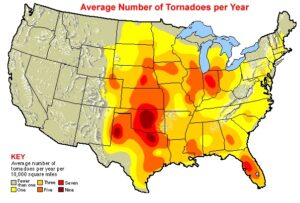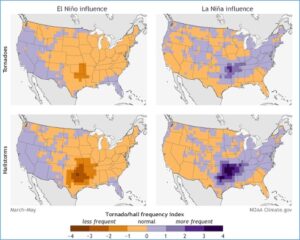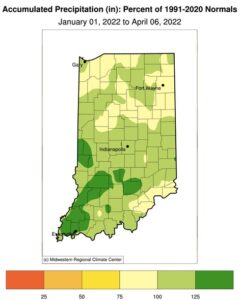Indiana’s been seeing a lot of rain lately, while avoiding severe weather such as hail, tornadoes, and strong winds. Will this mild pattern continue, or could things shift soon? The southern states along the Gulf coast have been experience what has seemed like non-stop severe weather with tornado watches (if not warnings) becoming almost a daily occurrence. What has happened? Typically, tornadoes are most common from Texas northward into the high plains states as well as the Midwestern states of Indiana and Illinois (Figure 1). This area has been traditionally referred to as “Tornado Alley”. There are climatological hot spots in Florida and southern Mississippi, but those are often attributed to landfalling hurricanes that spawn tornadoes. This year has been slightly different so far, but we cannot get a false sense of security too soon. April, May, and June tend to be the most active months for tornadoes in Indiana, so there’s still time. Tornadoes are energized by a strong contrast between cold, polar air from the north pushing up against the warm, tropical air from the south. Temperatures have not warmed up enough in Indiana to be the battleground location for these two extreme air masses. Another thought to ponder is the differences in tornadic activity in Indiana between El Niño springs and La Niña springs. Figure 2 shows the difference in both tornadic and hail frequency between these two global atmospheric-oceanic phases. Based upon climatology, southern Indiana has experienced more tornadoes and hail event during La Niñas than El Niños. Will this happen this year? For now, we need to just wait and see as the La Niña pattern lingers on. In the meantime, stay cognizant of the risks and have a safety plan in place, particularly for tornadoes.

Figure 1. Average number of tornadoes per year. Source: University Corporation for Atmospheric Research.

Figure 2. Relatively frequency of tornadoes and hail events based upon climatology during El Niño versus La Niña events. Source: NOAA Climate.gov
Weather forecasts are continuing to support above-normal precipitation for the next several weeks and months. Since the beginning of 2022, Indiana has been receiving near-normal to above-normal precipitation with the greatest excesses is the southwestern counties (Figure 3). Global circulation patterns seem to be sticking in place cause one rain event to quickly follow the previous one. Soil moisture has been showing no signs of concerning stress and groundwater supplies are replenishing nicely. With temperatures staying on the mild side, it has been challenging to get things dried out enough before the next rain event. Hopefully, temperatures will warm up soon to get vegetation thriving to help soak in some of that ground moisture and transpire it back into the atmosphere!
